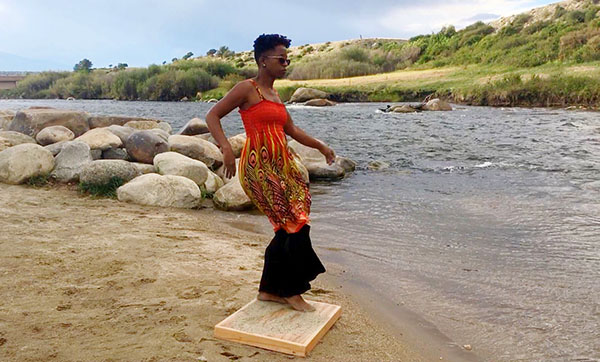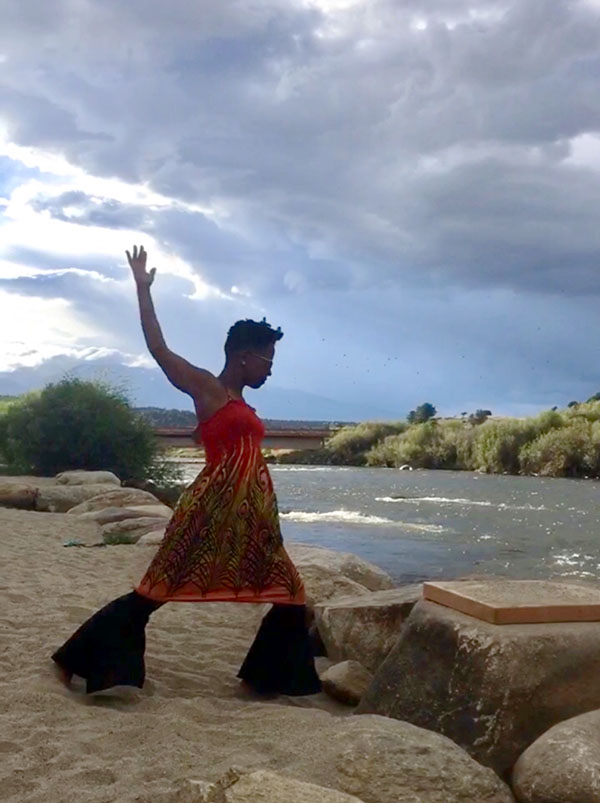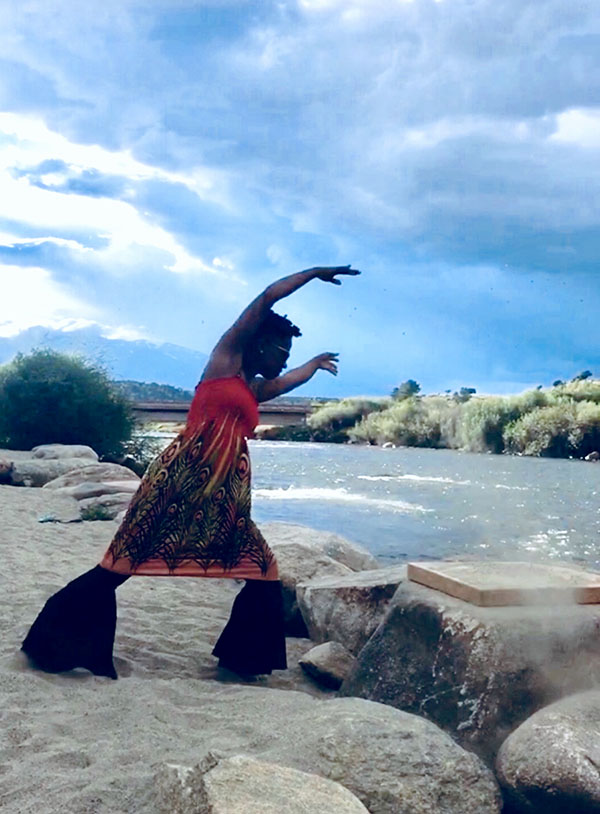Dancing on Sands
An Interview with Donne Lewis
BY EMMALY WIEDERHOLT, PHOTOS BY APRIL FREEMAN
Donne Lewis is a tap dancer and foot percussionist in Albuquerque, NM. About six years ago, she discovered tapping on sand in a workshop. Since then, she has devoted herself to studying and developing the art of dancing on sand.
~~
I was a kid who, at seven years old, had a journal and wrote down what I wanted to do when I grew up. On the list was: private detective, dancer and writer. When I was around 11, I took a tap class for about six weeks. Then we moved, as my father was in the Army. I didn’t have an opportunity to take tap again until I was 29 years old. That was the result of a car accident.
I’ve always been physically active. In my 20s, I was doing step aerobics. After my car accident, my physical therapist suggested I try something less strenuous. I’d always wanted to be a tap dancer, so I tried that. Of course, it was nowhere near less strenuous, and I spent 10 years managing back injuries while I learned how to do this thing I was super excited about.
When I say, “Super excited,” I mean it. I went to my first class after picking my son up from daycare. He sat in the corner drawing as I took my class. The next day I took three classes: beginning, beginning I and beginning II. Every day I focused on soaking up everything I could possibly learn because I was convinced that if I took classes every single day and practiced at home, I could catch up.
After six months, I was performing in the studio’s resident dance company. This was in Washington DC, at a studio called Joy of Motion. A year into dancing, my teacher, Nancy Newell, decided she was going to retire as company director, and her former student Artis Mooney took over. The company had been very suburban and middle-aged. They were not excited about someone young and ambitious taking over. Artis took the company to the next level, and everyone left except me. But it was awesome, because Artis focused on improvisation, which I had been fearful of. I’ve since lost all interest in recycled choreography. I view tap as a literal conversation.
I moved to Albuquerque because I went online and saw they had a thriving music and arts scene, 345 days of sunshine, and lower home prices. When I arrived, I realized it wasn’t the way I had envisioned it on the East Coast, but it was open and flexible enough that I could be anyone I wanted to become. I reached out to people to collaborate, especially music artists. I ended up teaching tap classes at the University of New Mexico before the tap program ended. At UNM, I met Stuart Smith, a musician and brilliant dance accompanist. He’s been in every project I’ve done in town.
There isn’t much in the way of continuing education for a professional tap dancer in New Mexico, so in 2014 I went to a workshop in Nyack, NY, run by Heather Cornell. Heather was the co-founder of Manhattan Tap, and many in the professional tap scene have studied under her. Each day of the workshop had a different focus, and one day was sand dance. Heather learned sand dance from Harriet “Quicksand” Browne, who was reputed to be a better sand dancer than Howard “Sandman” Sims, who most people are familiar with because that was his shtick at the Apollo Theater. I fell in love with sand dancing right away.
How would you describe sand dance to someone who has never seen it?
It is rhythmic percussive dance using sand and wood as instrumentation.
Early on, I was just trying to replicate tap on sand, but now I’m trying to make it something completely different. Where I’m going with the sand has evolved partly in response to audience expectations. If I had my way, I would be standing behind a screen and people would just listen to my rhythms, but audiences do not accept that. Because sand dancing is so different than tap dancing, I have to give audiences context for what’s happening with my feet. That made me ask: What do I do with my upper body? Am I directing the rhythm with my upper body? Am I using the upper body as leverage to control the momentum of the lower body? I’ve landed on the idea that what I want to do is fly on the sand, creating rhythms between moments of levitation.
What does a typical career in tap look like, and why did you decide not to follow that path?
The landscape of tap is much like all dance in the US. There are soloists and some professional collaborations of soloists who perform together. Then there are the many amateur tap companies that help feed the art. They’re not professional, but proficient enough to help keep the legacy of tap alive. Many of the current premier professionals came out of the Broadway show Bring in ‘da Noise, Bring in ‘da Funk, or have studied with those dancers. There are more than a handful of tap dancers today who make their living touring the world teaching and performing. It’s not the Shirley Temple variety; it’s hoofing with a musical virtuosity. It’s most often improvised within a structure, but beyond that, the dancers are responding to and collaborating with the musicians. I’d like to note that I’ve even seen this group of dancers evolve to more fully utilize their upper bodies in the past decade or so. It’s the next evolution of tap dancing.
I did not pursue that path because most professional tap dancers start dancing when they are six or seven and are quite virtuoso by the time they are 20. I felt I would have had to physically push my body in a way I didn’t think was necessary or healthy in order to be valid in that construct. In that world, tricks and moving quickly are very important. Who I am is a rebel. I want to be outside the box, and I don’t believe there is much room for me strictly in the construct of a tap dancer.
What does your current dance practice look like?
Daily I have a list of what I’m working on. It’s either footwork, the upper body, or the synthesis of those two things. I make sure the aesthetic matches the rhythmic quality I’m seeking. I study if there’s something I’m doing with my hands or upper body that pulls away from the rhythm or sends a mixed message. I break down everything I do.
I have a home studio, and I video record everything. Two to three hours a day is devoted to the practice and critique of my dancing. I mix up the time of day I practice depending on how I feel. I’m focused on attaining a level of virtuosity with my improvisation to the point that an audience would not know if it was choreographed.
I’ve spent a lot of time and money trying different footwear and types of sand. I even ordered pink garnet sand from Australia to test it out. I eventually settled on black magnetic sand from Pacific Beach in San Diego. Sands sound different. Even if sands look similar in grain size, they have different sonic qualities. The garnets, for example, were scratchy, and it was impossible to get a contiguous sound. The black magnetic sand from Pacific Beach, which is soft and powdery, doesn’t get pulverized, holds its shape, and collects together because it’s magnetic. And the sonic qualities are so smooth.
Regarding footwear, I knew at the workshop when I first discovered sand dance that I didn’t like the sound of the taps on sand and that I was going to take it and make something new. I first tried just pulling the taps off my shoes and working with leather bottoms. Then I tried differently weighted shoes to try to get a softer and less abrasive sound. I tried applying different materials on the bottom of shoes. I spent a fortune going back and forth to a shoe guy. I ordered $400 custom Capezios from Japan with wooden taps only to discover they didn’t fit, I could not send them back, and I didn’t like the sound. After taking some modern dance classes, I settled on using bare feet two years ago.
How does tap influence who you are as a sand dancer?
I’m always going to be a tap dancer. I love it. You can catch me anywhere – standing in line at the grocery store even – creating rhythms. But I’m not interested in it as my primary performance vehicle. There are already so many people doing tap and doing it well, I don’t have anything to add to that conversation at the moment. Tap, much like ballet, is rooted in deep historical context and has its masters. But it’s just not where I feel l have the most to say.
That being said, I appreciate that I had the opportunity to master tap to the extent I was interested in mastering it, because I am totally leveraging that knowledge and expertise for the sand, even if I’m not using many steps that would be recognizable as tap. Tap is the basis. The large muscles do the work, and the joints are completely flexible and fluid to allow for the use of momentum and gravity. I apply those same concepts to the sand. That’s what’s been interesting about studying the upper body; those concepts work the same way.
My goal is to create something brand new. I feel sand dance has a lot of potential. It doesn’t always have to be performed, but the kinesthetic qualities – how the vibrations feel through your body as you’re dancing on the sand – could have beneficial applications.
Any other thoughts?
I would die if I wasn’t sand dancing every single day!
~~




2 Responses to “Dancing on Sands”
Wonderful blog post! Such a miracle, dancers are, and their journeys.
This is so inspiring. Donne, I’m so glad to have met you at the Maple St. Showcase and seen a little bit (too little) of your sand tapping! I’ll look for you around town…
Lorien
Comments are closed.